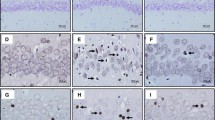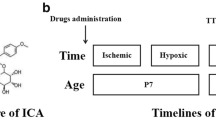Abstract
In neonates supraphysiological oxygen therapy has been demonstrated to cause neuronal death in hippocampus, prefrontal cortex, parietal cortex, and retrosplenial cortex. There is a need for the detection of novel neuroprotective drugs. Neuroprotective effects of lacosamide or memantine have been demonstrated in adult patients with ischemia, trauma and status epilepticus. The effects in immature brains may be different. This study aimed to evaluate neuroprotective effects of lacosamide and memantine treatment in a hyperoxia-induced brain injury model in immature rats. This study was performed in the Animal Experiments Laboratory of Dokuz Eylul University Faculty of Medicine. Neonatal Wistar strain rat pups were exposed to hyperoxia (80% oxygen + 20% nitrogen) for five days postnatally. They were divided into five groups; hyperoxia + lacosamide, hyperoxia + memantine, hyperoxia + lacosamide and memantine, hyperoxia + saline, control groups. After termination of the experiment, brain tissues were examined. Neuron counting in examined regions were found to be higher in hyperoxia + memantine and hyperoxia + lacosamide and memantine groups than hyperoxia + saline group. The presence of apoptotic cells evaluated with TUNEL and active Caspase-3 in hyperoxia + memantine and hyperoxia + lacosamide and memantine groups were found to be lower compared to hyperoxia + saline group. This study demonstrates that neuron death and apoptosis in newborn rat brains after hyperoxia is reduced upon memantine treatment. This is the first study to show the effects of memantine and lacosamide on hyperoxia-induced damage in neonatal rat brains.



Similar content being viewed by others
References
Yiş U, Kurul SH, Kumral A et al (2008) Hyperoxic exposure leads to cell death in the developing brain. Brain Dev 30(9):556–562. https://doi.org/10.1016/j.braindev.2008.01.010
Tataranno ML, Perrone S, Longini M, Buonocore G (2015) New antioxidant drugs for neonatal brain injury. Oxid Med Cell Longev 2015:108251. https://doi.org/10.1155/2015/108251
Reich B, Hoeber D, Bendix I, Felderhoff-Mueser U (2017) Hyperoxia and the immature brain. Dev Neurosci 38(5):311–330. https://doi.org/10.1159/000454917
Topçu Y, Bayram E, Özbal S et al (2014) Zonisamide attenuates hyperoxia-induced apoptosis in the developing rat brain. Neurol Sci 35(11):1769–1775. https://doi.org/10.1159/000454917
El-Dib M, Soul JS (2017) The use of phenobarbital and other anti-seizure drugs in newborns. Semin Fetal Neonatal Med 22(5):321–327. https://doi.org/10.1016/j.siny.2017.07.008
Komur M, Okuyaz C, Celik Y et al (2014) Neuroprotective effect of levetiracetam on hypoxic ischemic brain injury in neonatal rats. Child’s Nerv Syst 30(6):1001–1009. https://doi.org/10.1007/s00381-014-2375-x
Kurul SH, Yiş U, Kumral A et al (2009) Protective effects of topiramate against hyperoxic brain injury in the developing brain. Neuropediatrics 40(1):22–27. https://doi.org/10.1055/s-0029-1224101
Liu Y, Shangguan Y, Barks JDE, Silverstein FS (2012) Bumetanide augments the neuroprotective efficacy of phenobarbital plus hypothermia in a neonatal hypoxia-ischemia model. Pediatr Res 71(5):559–565. https://doi.org/10.1038/pr.2012.7
Kutzing MK, Luo V, Firestein BL (2012) Protection from glutamate-induced excitotoxicity by memantine. Ann Biomed Eng 40(5):1170–1181. https://doi.org/10.1007/s10439-011-0494-z
Huang CY, Wang LC, Wang HK et al (2015) Memantine alleviates brain injury and neurobehavioral deficits after experimental subarachnoid hemorrhage. Mol Neurobiol 51(3):1038–1052. https://doi.org/10.1007/s12035-014-8767-9
Liu C, Lin N, Wu B, Qiu Y (2009) Neuroprotective effect of memantine combined with topiramate in hypoxic-ischemic brain injury. Brain Res 1282:173–182. https://doi.org/10.1007/s12035-014-8767-9
Rao VL, Dogan A, Todd KG, Bowen KK, Dempsey RJ (2001) Neuroprotection by memantine, a non-competitive NMDA receptor antagonist after traumatic brain injury in rats. Brain Res 911(1):96–100. https://doi.org/10.1016/s0006-8993(01)02617-8
Shih T, McDonough JH Jr, Koplovitz I (1999) Anticonvulsants for soman-induced seizure activity. J Biomed Sci 6(2):86–96. https://doi.org/10.1007/bf02256439
Licko T, Seeger N, Zellinger C, Russmann V, Matagne A, Potschka H (2013) Lacosamide treatment following status epilepticus attenuates neuronal cell loss and alterations in hippocampal neurogenesis in a rat electrical status epilepticus model. Epilepsia 54(7):1176–1185. https://doi.org/10.1111/epi.12196
Behr C, Lévesque M, Ragsdale D, Avoli M (2015) Lacosamide modulates interictal spiking and high-frequency oscillations in a model of mesial temporal lobe epilepsy. Epilepsy Res 115:8–16. https://doi.org/10.1016/j.eplepsyres.2015.05.006
Wang B, Dawson H, Wang H et al (2013) Lacosamide improves outcome in a murine model of traumatic brain injury. Neurocrit Care 19(1):125–134. https://doi.org/10.1007/s12028-012-9808-8
Choi HY, Park JH, Chen BH et al (2016) Increases of catalase and glutathione peroxidase expressions by lacosamide pretreatment contributes to neuroprotection against experimentally induced transient cerebral ischemia. Neurochem Res 41(9):2380–2390. https://doi.org/10.1007/s11064-016-1951-8
Romijn HJ, Hofman MA, Gramsbergen A (1991) At what age is the developing cerebral cortex of the rat comparable to that of the full-term newborn human baby? Early Hum Dev 26(1):61–67. https://doi.org/10.1016/0378-3782(91)90044-4
Semple BD, Blomgren K, Gimlin K, Ferriero DM, Noble-Haeusslein LJ (2013) Brain development in rodents and humans: Identifying benchmarks of maturation and vulnerability to injury across species. Prog Neurobiol 106–107:1–16. https://doi.org/10.1016/j.pneurobio.2013.04.001
Paxinos G, Watson C (1986) The rat brain in stereotaxic coordinates, 2nd edn. Academic Press, New York
Gerstner B, DeSilva TM, Genz K et al (2008) Hyperoxia causes maturation-dependent cell death in the developing white matter. J Neurosci 28(5):1236–1245. https://doi.org/10.1523/JNEUROSCI.3213-07.2008
Felderhoff-Mueser U, Bittigau P, Sifringer M et al (2004) Oxygen causes cell death in the developing brain. Neurobiol Dis 17(2):273–282. https://doi.org/10.1016/j.nbd.2004.07.01
Sengoku T, Murray KM, Wilson ME (2016) Neonatal hyperoxia induces alterations in neurotrophin gene expression. Int J Dev Neurosci 48:31–37. https://doi.org/10.1016/j.ijdevneu.2015.11.003
Akdogan I, Goksin-Yonguc N (2011) Experimental epilepsy models and morphologic alterations of experimental epilepsy models in brain and hippocampus. In: Kaneez FS (ed) Underlying mechanisms of epilepsy. InTech, New York
Fujita S, Toyoda I, Thamattoor AK, Buckmaster PS (2014) Preictal activity of subicular, CA1, and dentate gyrus principal neurons in the dorsal hippocampus before spontaneous seizures in a rat model of temporal lobe epilepsy. J Neurosci 34(50):16671–16687. https://doi.org/10.1523/JNEUROSCI.0584-14.2014
Kim GH, Byeon JH, Eun BL (2017) Neuroprotective effect of lacosamide on hypoxic-ischemic brain injury in neonatal rats. J Clin Neurol 13(2):138–143. https://doi.org/10.3988/jcn.2017.13.2.138
Effgen GB, Morrison B (2017) Memantine reduced cell death, astrogliosis, and functional deficits in an in vitro model of repetitive mild traumatic brain injury. J Neurotrauma 34(4):934–942. https://doi.org/10.1089/neu.2016.4528
Chen B, Wang G, Li W et al (2017) Memantine attenuates cell apoptosis by suppressing the calpain-caspase-3 pathway in an experimental model of ischemic stroke. Exp Cell Res 351(2):163–172. https://doi.org/10.1016/j.yexcr.2016.12.028
Landucci E, Filippi L, Gerace E, Catarzi S, Guerrini R, Pellegrini-Giampietro DE (2018) Neuroprotective effects of topiramate and memantine in combination with hypothermia in hypoxic-ischemic brain injury in vitro and in vivo. Neurosci Lett 668:103–107. https://doi.org/10.1016/j.neulet.2018.01.023
Tomitaka S, Hashimoto K, Narita N, Sakamoto A, Minabe Y, Tamura A (1996) Memantine induces heat shock protein HSP70 in the posterior cingulate cortex, retrosplenial cortex and dentate gyrus of rat brain. Brain Res 740(1–2):1–5. https://doi.org/10.1016/s0006-8993(96)00842-6
Funding
There is no funding.
Author information
Authors and Affiliations
Contributions
All authors contributed to the study conception and design. The study was designed and conceptuilized by İP, UY and SHK. Material preparation, data collection and analysis were performed by İpek Polat, EB, MA, DO, PE, CP. Reproduction of animals, care of animals were done by MÇ and OY. Sacrification was done by İP and MÇ. Histological experiments were done by SCM and KT. The first draft of the manuscript was written by İpek Polat and all authors commented on previous versions of the manuscript. UY and SHK critically reviewed and edited the manuscript. All authors read and approved the final manuscript.
Corresponding author
Ethics declarations
Conflict of interest
All the authors declare that there is no conflict of interest.
Ethical Approval
All applicable international, national, and institutional guidelines for the care and use of animals were followed. All procedures performed in studies involving animals were in accordance with the ethical standards of the institution. Approval was obtained from the Ethics Committee of Animal Experiments of Dokuz Eylül University Local Ethics Committees (Approval Date/Number: 27.12.2016-71/2016).
Additional information
Publisher's Note
Springer Nature remains neutral with regard to jurisdictional claims in published maps and institutional affiliations.
Rights and permissions
About this article
Cite this article
Polat, İ., Cilaker Mıcılı, S., Çalışır, M. et al. Neuroprotective Effects of Lacosamide and Memantine on Hyperoxic Brain Injury in Rats. Neurochem Res 45, 1920–1929 (2020). https://doi.org/10.1007/s11064-020-03056-5
Received:
Revised:
Accepted:
Published:
Issue Date:
DOI: https://doi.org/10.1007/s11064-020-03056-5




